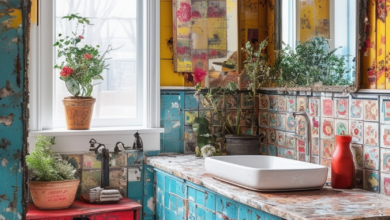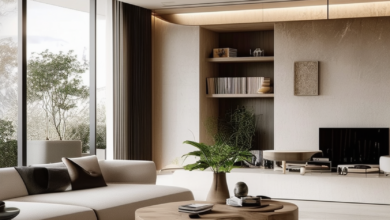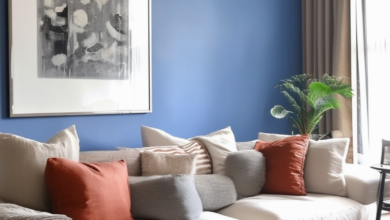Creating the Perfect Palette: Unleashing the Power of Colour in Your Living Room
The living room is often considered the heart of the home, a place where family and friends gather to relax, unwind, and create lasting memories. One of the most impactful ways to enhance the ambiance of this space is through the use of color. Whether you prefer a soothing and tranquil environment or a bold and vibrant statement, the perfect palette can truly transform your living room into a sanctuary that reflects your personal style and taste. In this article, we will explore the art of creating the perfect palette and unleash the power of color in your living room.
From subtle neutrals to striking hues, choosing the right colors for your living room can be a daunting task. By understanding the psychology of color and how different shades can evoke specific emotions and moods, you can create a space that not only looks visually appealing but also feels harmonious and welcoming. Whether you opt for a monochromatic scheme for a sense of cohesion or a complementary palette for added depth and contrast, the possibilities are endless when it comes to transforming your living room with color. Join us on a journey of exploration and inspiration as we delve into the art of creating the perfect palette and unleashing the power of color in your living room.
Choosing the Right Colour Combination for Your Living Room
When it comes to designing your living room, choosing the right colour combination is crucial in creating a space that reflects your personality and style. Colour has the power to impact the mood and atmosphere of a room, so it’s important to choose wisely. By carefully selecting a palette that complements your furniture, decor, and overall aesthetic, you can create a space that is both inviting and visually appealing.
One way to approach selecting a colour scheme for your living room is to start with a base colour that will serve as the foundation for the room’s design. This could be a neutral tone like white, grey, or beige, or a bold colour like navy blue or emerald green. Once you have chosen your base colour, you can then build upon it by adding accent colours that will bring depth and interest to the space. Consider using a mix of warm and cool tones to create a balanced and harmonious look.
Another important factor to consider when choosing a colour combination for your living room is the size and layout of the space. Lighter colours tend to make a room feel larger and more open, while darker colours can create a sense of coziness and intimacy. It’s also important to take into account the natural light that enters the room, as this can affect how the colours appear. By experimenting with different shades and tones, you can create a colour scheme that enhances the overall look and feel of your living room.
Understanding the Psychology of Colour in Interior Design
When it comes to designing your living room, the power of colour cannot be underestimated. Different hues can evoke various emotions, create different atmospheres, and even affect how spacious a room feels. By understanding the psychology of colour, you can harness the power of each shade to create the perfect palette for your living space.
Warm and Cozy: Reds, oranges, and yellows are considered warm colours that can create a cozy and inviting atmosphere in your living room. These hues can help make a large space feel more intimate and welcoming.
Cool and Calm: Blues, greens, and purples are cool colours that can bring a sense of tranquility and relaxation to your living room. These shades are perfect for creating a soothing environment, perfect for unwinding after a long day.
Tips for Harmonizing Different Hues in Your Living Space
When it comes to decorating your living space, choosing the perfect color palette can make all the difference. By harmonizing different hues, you can create a cohesive and inviting atmosphere that reflects your personal style. To unleash the power of color in your living room, consider the following tips:
Firstly, start by selecting a base color that will serve as the foundation for your overall color scheme. This could be a neutral hue such as white, beige, or grey, which will provide a versatile backdrop for the rest of your décor. Once you have your base color chosen, you can then begin to layer in accent colors to add depth and interest to the room. Consider using a mix of warm and cool tones to create a balanced and harmonious look.
Another tip for harmonizing different hues in your living space is to pay attention to the proportions of each color within the room. Aim to have a good balance of light and dark colors, as well as bold and subtle shades. You can achieve this by incorporating various textures and patterns into your décor, such as using throw pillows, rugs, and curtains in different colors and materials. By playing with different elements, you can create a dynamic and visually appealing space that is sure to impress.
The Dos and Don’ts of Creating a Vibrant Colour Palette in Your Home
When it comes to creating a vibrant colour palette in your home, there are certain dos and don’ts to keep in mind. By carefully selecting the right colours, you can transform your living room into a space that feels inviting and visually appealing.
Do:
-
- Start by choosing a base colour that will serve as the foundation for your colour palette.
-
- Consider the mood and atmosphere you want to create in the room, and select colours that align with that vision.
-
- Use a variety of colours to add depth and interest to the space, but be sure to maintain a cohesive look by sticking to a consistent colour scheme.
Don’t:
-
- Avoid using too many bold or clashing colours, as this can create visual chaos and make the room feel overwhelming.
-
- Avoid choosing colours that are too bright or intense, as they can be too stimulating and detract from the overall ambiance of the room.
-
- Avoid neglecting the impact of natural light on your colour choices, as different lighting conditions can alter the way colours appear in a space.



